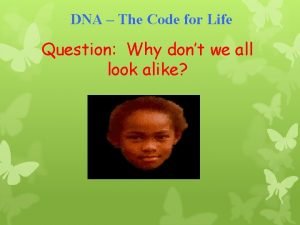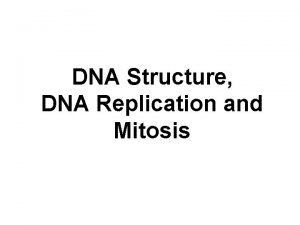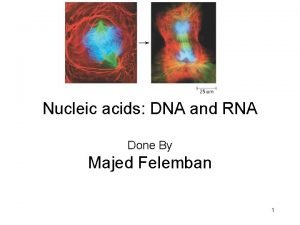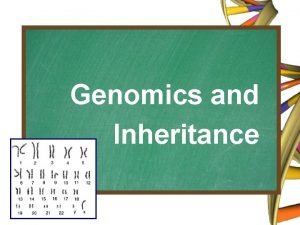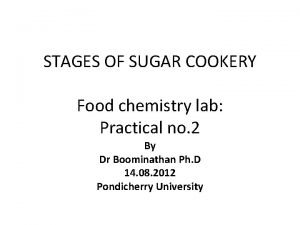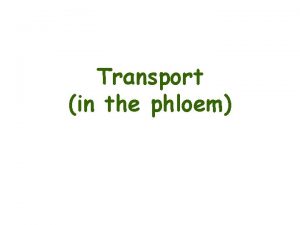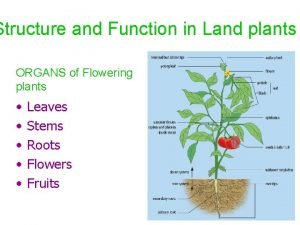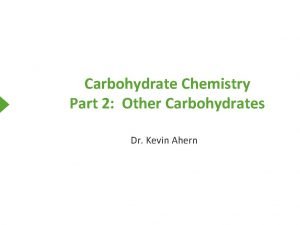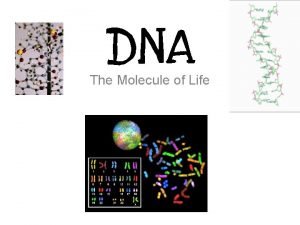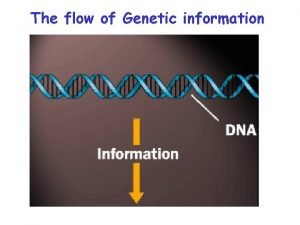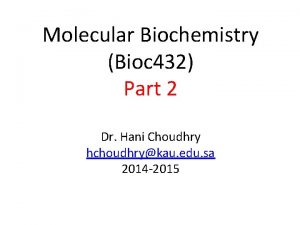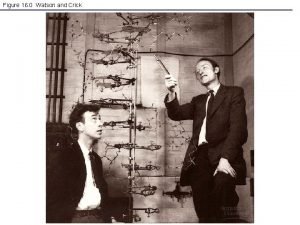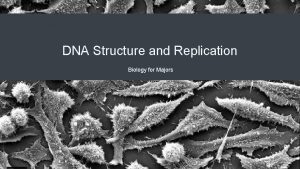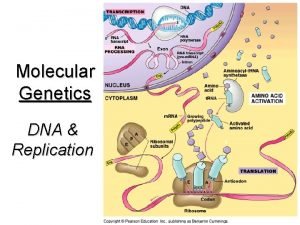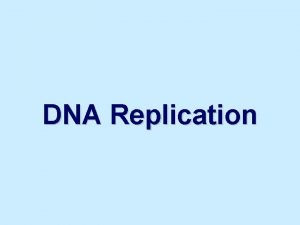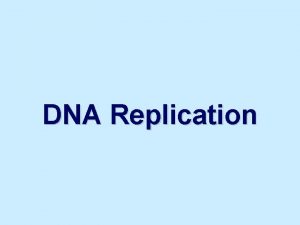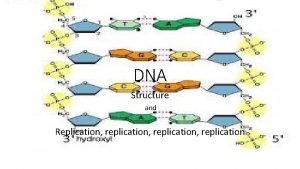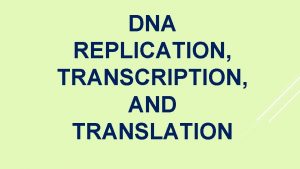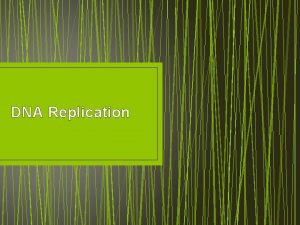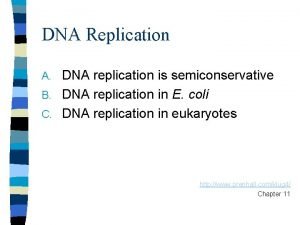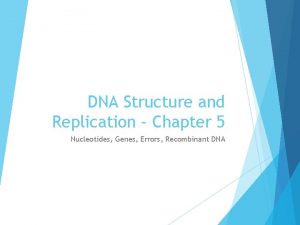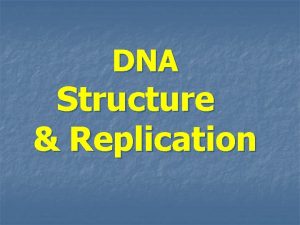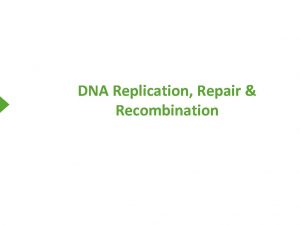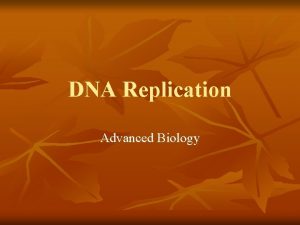DNA Structure and replication Nucleotides 3 components Sugar





















- Slides: 21

DNA Structure and replication

Nucleotides 3 components Sugar Phosphate Organic base

A bit more about nucleotides • Nitrogen-containing base • Pentose sugar • Base has H sticking out

Bases • 4 different bases: – – Guanine Adenine Thymine Cytosine • Purines = A & G (bigger, 2 rings) • Pyrimidines = C, T (smaller, 1 ring)

Joining the nucleotides • The nucleotides join together • Condensation reaction • ‘Sugar phosphate backbone’ • Polynucleotide strand

Joining the strands • 2 polynucleotide strands • running in opposite directions • complimentary base pairing • hydrogen bonds • A with T • C with G

The Double Helix • A-T 2 hydrogen bonds • G-C 3 hydrogen bonds • ‘twisted ladder’ • 10 base pairs for every complete turn of the helix

DNA replication

DNA Replication

DNA Replication DNA unzips Nuceotides in the cytoplasm attach to the two strands by basepairing DNA polymerase catalyses the process Each strand acts as a template

DNA Replication Meselson and Stahl Grew microbes in 15 N growth medium Then repeatedly on 14 N growth medium DNA was extracted and separated by centrifugation

DNA Replication

Making a Protein

Genetic Code • The code is a 3 -letter triplet code. • Each sequence of 3 bases = 1 amino acid. • e. g. ATG=Met, TTT=Lys (called a codon in m. RNA) • 20 different amino-acids used to make proteins. • Triplet codes for 43=64 (spares are repeats, stops, start is always Met)

Protein Synthesis • The DNA sequence encodes for the primary protein sequence. • Cell functions are determined by proteins (enzymes) so DNA determines cell activities by determining protein synthesis. Click to watch an animation

Stage 1: Transcription • • DNA base sequence determines the amino acid sequence. Takes place in nucleus DNA unwinds Complementary copy (by base pairing) of the coding sequence is made from RNA (m. RNA) using one strand of DNA as template. Click to watch an animation

More about Transcription • • Synthesis is always 5'->3' (extends from 3'OH). Carried out by RNA polymerase m. RNA leaves nucleus. [Splicing out of introns occurs in nucleus] Click to watch an animation

Stage 2: Translation • m. RNA leaves nucleus and attaches to ribosome in CYTOPLASM. • Ribosome made of r. RNA & protein • m. RNA binds to small subunit • 1 st amino acid is always AUG (start codon) = Met • In cytoplasm there are 64 different molecules of t. RNA each with a specific triplet anticodon. Click to watch an animation

More about Translation • Each t. RNA has a specific amino acid attached by a specific amino-acyl t. RNA synthetase enzyme. • Process uses ATP & forms activated molecule to provide energy for peptide bond • The anticodon of the correct t. RNA then pairs with the codon of the m. RNA. • This brings two t. RNAs together in the ribosome and allows a peptide bond to be formed between the two amino acids by peptidyl transferase. • Continues until reach one of the three stop codons (UAA, UAC, UGA). Click to watch an animation

Genes & Genomes • Human genome 3 x 109 bp • 3% protein coding • 97% other functions e. g. telomeres or unknown function (‘junk DNA’) • Section of DNA that codes for a polypeptide is a GENE. • In humans 100, 000 genes (not all expressed in each cell) • Genome=total set of information in one cell. Click to read more

 Bioflix activity dna replication dna replication diagram
Bioflix activity dna replication dna replication diagram Replication fork
Replication fork Dna and genes chapter 11
Dna and genes chapter 11 When dna untwists, unzips, and nucleotides fill in.
When dna untwists, unzips, and nucleotides fill in. Haploid vs diploid
Haploid vs diploid Multiple choice questions on dna structure and replication
Multiple choice questions on dna structure and replication Nature of dna replication
Nature of dna replication Four nucleotides of dna
Four nucleotides of dna Order of nucleotides in dna
Order of nucleotides in dna Nucleotide vs nucleoside
Nucleotide vs nucleoside Sugar temperature stages
Sugar temperature stages Reducing and non reducing sugar
Reducing and non reducing sugar Sugar sink in plants
Sugar sink in plants Labeled vascular bundle
Labeled vascular bundle Reducing vs. non-reducing sugars
Reducing vs. non-reducing sugars Dna replication transcription and translation
Dna replication transcription and translation Dna replication steps
Dna replication steps Dna replication is semi-conservative
Dna replication is semi-conservative Okazaki fragments
Okazaki fragments 3 models of dna replication
3 models of dna replication Major enzymes in dna replication
Major enzymes in dna replication Accgtat
Accgtat



